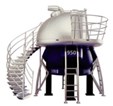World's First 950mhz Magnet For Nuclear Magnetic Resonance Is Introduced

 Another industry breakthrough for Oxford Instruments Superconductivity; the world's first commercial 950 MHz magnet is now at field and being prepared for delivery to Oxford University in September 2005. The system, which was sold directly to Oxford University, is demonstrating excellent all round performance. The base drift rate is less than 5 Hz per hour -a fundamental parameter for long-term biomolecular NMR experiments and crucial in obtaining excellent data.
Another industry breakthrough for Oxford Instruments Superconductivity; the world's first commercial 950 MHz magnet is now at field and being prepared for delivery to Oxford University in September 2005. The system, which was sold directly to Oxford University, is demonstrating excellent all round performance. The base drift rate is less than 5 Hz per hour -a fundamental parameter for long-term biomolecular NMR experiments and crucial in obtaining excellent data.
The 950 MHz system also validates the company's new, proprietary, niobium-based superconductor, developed to provide enhanced critical current density capacity (Jc). The introduction of this new superconductor is a major breakthrough as it provides the additional current density necessary for the development of compact Ultra High Field NMR magnet systems. This technology also provides a significant competitive advantage for Oxford Instruments, alleviating the dependence on developing exotic high temperature superconductors, which would otherwise be required to achieve the same field strength.
These new proprietary conductors combined with ‘femto Ohm' superconducting jointing technology are key elements required to achieve stable operation. This technology has also enabled the company to achieve rapid time to market for a unique range of ‘compact' magnets, such as the Actively Shielded AS800MHz system, and is key to the success of the 1GHz programme.
Once installed, the 950 MHz magnet will provide the University's NMR Protein Structure Group with the highest degrees of sensitivity and resolution ever available for NMR spectroscopy. This will allow data collection and analysis of biomolecules over 100 kDa in size, proving the team with new insights into the structure and intra-molecular interactions of a wide range of proteins.
This announcement follows Oxford Instruments' recent initiative to supply NMR magnets directly to the end user market place, effectively reducing third party pricing margins.
SOURCE: Oxford Instruments
